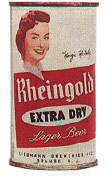[an error occurred while processing this directive]
Antique Beer Photos:

Dozens of prints available in a variety of sizes up to 40x50. |  |
|
|
Who'll Be New York's Favorite Girl?
The Miss Rheingold Contest.
(Excerpt from Will Anderson's book From Beer To Eternity, available at BeerBooks.com.)
 "I remember running from store to store, grabbing as many ballots as I could. In the neighborhood there sure wasn't talk about the election for mayor or governor ... but when it came to the Miss Rheingold Contest, everybody was involved. The talk was all about it. Everybody talked about it ... and everybody voted." "I remember running from store to store, grabbing as many ballots as I could. In the neighborhood there sure wasn't talk about the election for mayor or governor ... but when it came to the Miss Rheingold Contest, everybody was involved. The talk was all about it. Everybody talked about it ... and everybody voted."
-- John Corrado, resident of East Harlem, New York City during the 1940s and 1950s.
Yes, everybody certainly voted. And voted. And voted. Ten or fifteen votes cast at a clip was nothing; twenty or thirty votes, now that was a worthwhile effort.
Miss Rheingold Contest-time was the only time of the year I actually hoped my mother would ask (tell!) me to run down�town to Louie's Market to get some frozen peas or a can of mushroom gravy. After all, how exciting are frozen peas? But the duel to be Miss Rheingold ... now that was exciting! Sometimes it was more than exciting. If you were pulling for -- and voting for -- Pat Burrage while Tony Toughissimo was pulling for -- and voting for -- Liz Hastings, it could be downright dangerous. "Intellectual discussion" as to who should win might all too easily turn into physical confrontation: "Whaddya mean Pat Burrage is better looking than Liz Hastings? Whaddya, blind or somethin'?"
The Miss Rheingold Contest was SERIOUS business. How it all started was less than serious. It was accidental. The story goes that a printing salesman called upon Liebmann Brewery president Philip Liebmann early in 1940. The salesman's sample kit included several shots of Jinx Falkenburg, at the time a semi-actress, semi-celebrity best known for her tennis playing. Ms. Falkenburg's photos were part of a batch being used to demonstrate a new printing process the salesman's firm had developed.
Recalled Philip Liebmann twenty years later: "The printing process was revolutionary, but the girl was spectacular. I thought she might be what we needed to promote our beer. We decided to put her under contract for 1940 and hitch our publicity to that face. For the next months she appeared in our advertising, and we were very happy with the results. In 1941 we did it a little differently: we let our dealers pick a girl from a folder we sent out bearing pictures of a couple of dozen beauties. In 1942 the voting was left to the public, and from a count of two hundred thousand then, the interest has grown each year. The total votes for Miss Rheingold 1959 exceeded twenty-two million. Only one other election in the country draws more attention at the polls, and I don't need to identify that one."
"That one," of course, was the presidential election ... and it wasn't held every year.
Alas, though, the presidential election is still held, still with us, but the Miss Rheingold Contest is long gone. Miss Rheingold of 1964, Celeste Yarnall, was the last winner elected by public vote. The 1965 Miss Rheingold, Sharon Vaughn, was selected by the brewery rather than the public, just as Jinx Falkenburg had been crowned a quarter of a century earlier.
Miss Vaughn was to be the last Miss Rheingold. The official reason given by the brewery for the demise of the contest was waning interest on the part of the public. The unofficial -- and probably truer -- reason was that Liebmann was rapidly sliding into a no-win situation. If they were to continue to have only lily-white Miss Rheingold contestants, the important black and Hispanic markets would feel cheated; but if a black or Hispanic were to win, the company could genuinely fear white backlash. If there's no way to win, why bother to play? Liebmann decided not to. And so ended one of New York's most famous -- and certainly most fun -- annual traditions.
Going to the store for frozen peas was never to be the same again.
|

